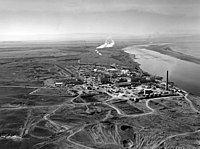
Photo from wikipedia
A self-generated, strippable hydrogel containing adsorbents was developed to remove the radioactive cesium from surfaces by adsorption for wide-area surface decontamination. Two aqueous polymeric solutions of polyvinyl alcohol (PVA) and… Click to show full abstract
A self-generated, strippable hydrogel containing adsorbents was developed to remove the radioactive cesium from surfaces by adsorption for wide-area surface decontamination. Two aqueous polymeric solutions of polyvinyl alcohol (PVA) and phenylboronic-acid-grafted alginate (PBA-Alg) were easily applied to surfaces and subsequently self-generated a hydrogel based on the PBA-diol ester bond. Compared to the strippable coating and chemical gels, the PBA-diol ester bond-based hydrogel was easily peeled off the surfaces without a drying step due to its high elasticity, which is more practical and time saving. The resulting hydrogel displayed high 137Cs removal efficiencies of 91.61% for painted cement, 97.505% for aluminum, 94.05% for stainless steel, and 53.5% for cement, which was 2.3 times higher than that of Decongel due to the presence of the adsorbent in the hydrogel having an excellent Cs distribution coefficient (3.34 × 104 mL/g). Moreover, the volume of radioactive waste generated after the surface decontamination could be reduced by a simple magnetic separation of the adsorbent from the used hydrogel, which can reduce the waste disposal cost. Therefore, our hydrogel system has great potential as a new, cost-effective surface decontaminant in various nuclear industry fields including wide-area environmental remediation after a nuclear accident or terrorist attack.
Journal Title: Journal of hazardous materials
Year Published: 2019
Link to full text (if available)
Share on Social Media: Sign Up to like & get
recommendations!